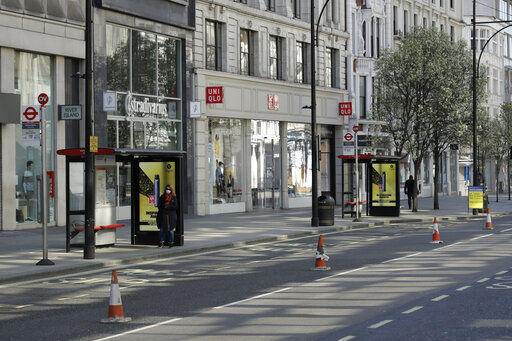LONDON — The British economy has recorded the deepest coronavirus-related slump among the world’s leading industrial economies after official figures today showed it shrinking by a fifth in the second quarter alone.
The 20.4% quarter-on-quarter drop in the April to June period is worse than anything since records began in 1955, the Office for National Statistics said.
Following a 2.2% contraction in the first three months of the year, the U.K. economy is now in recession, commonly defined as two quarters of contraction.
Britain’s recession is deeper than those recorded by comparable economies in Europe, notably Germany, France and Italy, or that of the United States. The other Group of Seven economies, Japan and Canada, have yet to post second-quarter numbers but no economist thinks they will be as bad as the U.K.’s.
Kallum Pickering, senior economist at Berenberg Bank, said the main reason why the U.K. economy has fared so badly is that the lockdown was introduced at “a later stage” in the outbreak, particularly when compared with others in Europe.
By the time Prime Minister Boris Johnson introduced the lockdown on March 23, the U.K. had “a bigger first wave” than could have otherwise been the case, meaning restrictions had to persist for relatively longer. Shops in Germany, for example, reopened on May 6 compared with June 15 in England.
The U.K. has the highest official coronavirus-related death toll in Europe with 46,611 deaths. The actual death toll is believed to be higher as the official dataset only incorporates those who have tested positive for COVID-19.
Unlike others, Britain’s statistics agency provides monthly growth figures and these offer hope that the economy is healing as lockdown restrictions are eased. In June, the British economy grew by a monthly 8.7%.
“The economy began to bounce back in June with shops reopening, factories beginning to ramp up production and house-building continuing to recover,” said statistician Jonathan Athow.
The British government hopes additional measures such as the reopening of pubs and restaurants and a return to offices will further fuel the recovery.
However, Samuel Tombs, senior U.K. economist at Pantheon Macroeconomics, thinks the U.K. economy will “lag” others because of “structural disadvantages,” notably the fact that the economy is so dependent on the services sector, where human interactions are so much more crucial than in manufacturing or construction.
Whatever the scale of the bounceback in coming months, it’s almost inevitable that unemployment will sky-rocket, potentially more than doubling to the 3 million mark last seen in the 1980s.
“I’ve said before that hard times were ahead, and today’s figures confirm that hard times are here,” said Treasury chief Rishi Sunak. “Hundreds of thousands of people have already lost their jobs, and sadly in the coming months many more will.”
So far, the British government has kept a lid on the official unemployment numbers, through a salary support package that has given hard-pressed firms the opportunity to retain workers rather than fire them.
Under the Coronavirus Job Retention Scheme, the government has been paying a large chunk of the salaries of workers retained. Some 1.2 million employers have taken advantage of the program to furlough 9.6 million people at a cost to the government of 33.8 billion pounds ($44 billion).
Sunak is ending the program in October but insists “nobody will be left without hope or opportunity.”
Unions are urging him to extend the program to sectors still suffering from restrictions.
“The best way to get our economy back on its feet is to keep people in work,” said Frances O’Grady, general secretary at the umbrella Trades Union Congress.
The British economy faces further headwinds aside from the pandemic, notably its future trading relationship with the European Union following the U.K.’s departure from the bloc in January.
The U.K. is currently in a transition period whereby it remains part of the EU’s tariff-free arrangements until the end of the year. The future economic relationship has yet to be agreed, meaning tariffs could be imposed on traded goods between the two sides come the start of next year.


